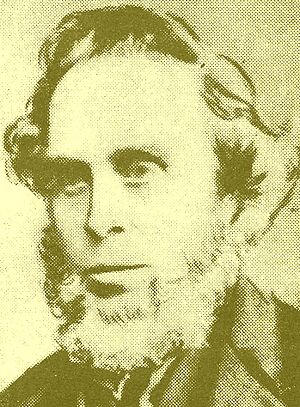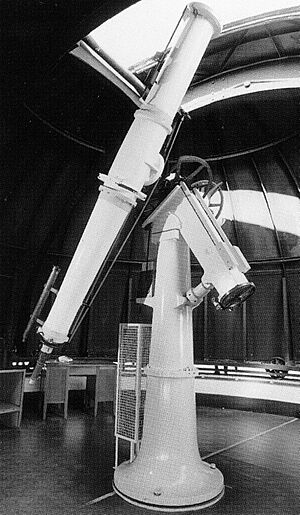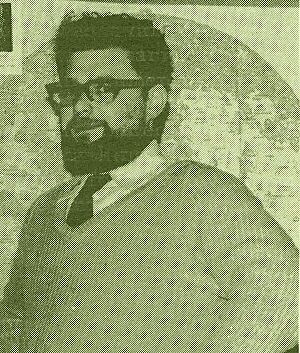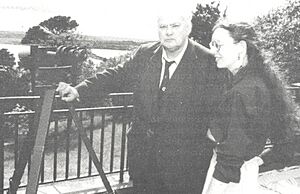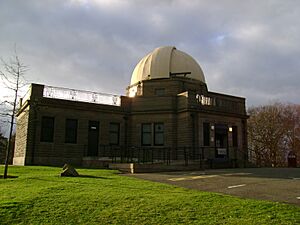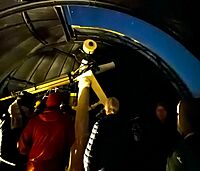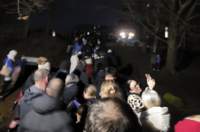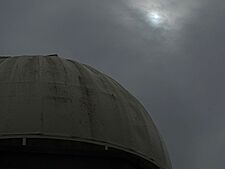Mills Observatory facts for kids
Quick facts for kids Mills Observatory |
|||||||||||||||
|---|---|---|---|---|---|---|---|---|---|---|---|---|---|---|---|
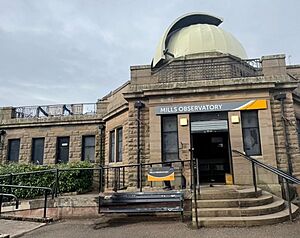 |
|||||||||||||||
| Location | Balgay Hill, Dundee, Scotland | ||||||||||||||
|
Coordinates
|
56°27′53.93″N 3°00′45.27″W / 56.4649806°N 3.0125750°W
|
||||||||||||||
| Established | 28 October 1935 | ||||||||||||||
| Website Official Mills Observatory Website: http://www.leisureandculturedundee.com/mills/ |
|||||||||||||||
|
|||||||||||||||
Mills Observatory is a special place in Dundee, Scotland. It was the very first building in the United Kingdom made just for the public to look at the stars. It sits on top of Balgay Hill and opened in 1935. The observatory is built from sandstone and has a unique 7-meter dome. Inside, you'll find an old Victorian telescope, a small planetarium, and cool displays about space. The dome is one of only two made from papier-mâché that are still around in the UK! Leisure & Culture Dundee runs the observatory today.
Contents
Exploring the History of Mills Observatory
How it All Started
The idea for Mills Observatory came from John Mills (1806–1889). He was a businessman in Dundee who loved astronomy. John Mills was inspired by Reverend Thomas Dick, a writer who believed studying astronomy helped people understand the world better. Dick thought every city should have public parks, libraries, and observatories.
John Mills even built his own private observatory. It was on Dundee Law, another hill in the city. He had a special telescope and a room to record his observations. One of his old telescopes is now on display at the Royal Observatory, Edinburgh.
When John Mills passed away, he left money for a public observatory. The city council wasn't sure what to do at first. They even offered the money to the University College, but the university said no.
Finding the Perfect Spot
Plans were made to build the observatory on Dundee Law. But then First World War started in 1914, and the project was put on hold. The spot on Dundee Law was later used for a war memorial.
In the 1930s, during the Great Depression, the idea came up again. Building the observatory would create much-needed jobs. Professor Sampson, who was the Astronomer Royal for Scotland, helped choose the best location. He looked at several places but strongly suggested Balgay Hill. It was perfect for looking at the stars and easy for people to visit.
Even though most big observatories are far from cities, Balgay Hill is special. It's on a hill overlooking a river, and trees help protect it from city lights. This means people can see the stars from there about 40% of the nights each year.
Building and Opening the Observatory
Professor Sampson worked with James MacLellan Brown, the city's architect. They designed a modern building using sandstone blocks. The observatory was officially opened on October 28, 1935.
The first person in charge, called the Curator, was J. Grant Bruce. He was a part-time worker. The observatory was open to the public on Monday, Wednesday, and Friday evenings in winter. Tuesdays and Thursdays were for groups. During the day and in summer, visitors could use special telescopes to view the scenery from the balcony.
The main telescope when it opened was an 18-inch (450 mm) reflecting telescope. The dome itself was made of papier-mâché on a steel frame. It was operated by hand.
During Second World War, the observatory closed. After the war, the 18-inch telescope was replaced. Scientists from St. Andrews University used the observatory to test a new type of telescope. This new telescope was great for taking photos of space.
The Cooke Telescope Arrives
However, city lights made it hard to take good photos from Dundee. So, in 1951, the special photographic telescope was moved to St. Andrews University. In return, Mills Observatory received a 10-inch (250 mm) Cooke refracting telescope.
This Cooke telescope was built in 1871 and was much better for people to look through. It's excellent for seeing details on the Moon and planets. Even though it's old, it can still take great photos with modern cameras.
New Leaders and Moon Landings
After Curator Bruce passed away, Jaroslav Císař became the new Curator in 1952. He was a research astronomer from St. Andrews. Dr. Císař started popular astronomy classes and encouraged young people to get involved. This led to the creation of the Dundee Astronomical Society.
Harry Ford, a local amateur astronomer, became Dr. Císař's assistant. When Dr. Císař retired, Harry Ford became the first full-time Curator in 1972. This meant the observatory could be open all the time.
Harry Ford made the observatory very popular. He created programs to teach the public and held "Open Days." Famous TV astronomer Patrick Moore praised the observatory's work.
The years from 1971 to 1977 were very exciting. People were fascinated by space missions, especially the Apollo missions to the Moon. In July 1969, during the Apollo 11 Moon landing, the observatory had its biggest crowd ever. People watched the mission on a color TV and enjoyed talks and exhibitions.
Harry Ford also went on an expedition to observe a total solar eclipse in 1973. The photos from this trip are an important part of the observatory's history.
Modern Updates and New Discoveries
In 1982, Dr. Fiona Vincent became the City Astronomer. The observatory received a grant that allowed for big improvements. They added central heating, redid the balcony, and updated the lecture room. Patrick Moore officially opened these new facilities in 1984.
In 1990, an astronomer named Robert H. McNaught discovered two minor planets. He named them 6906 Johnmills and 6907 Harry Ford, honoring the observatory's founder and its first full-time curator.
The observatory started regular "Open Nights" in the 1990s to welcome more people. Crowds also gathered to see the August 1999 solar eclipse.
New Millennium, New Look
In 2003, the observatory got a big makeover with help from the Heritage Lottery Fund. They added disabled access and other new features. HRH the Princess Royal reopened it in February 2004.
A 350-meter "Planet Trail" was also opened in June 2004. It's a path with standing stones and plaques representing the planets in our Solar System. You start at the "Sun" on one hill and walk towards the observatory, which represents "Pluto."
In 2005, Apollo 15 astronaut David Scott visited the observatory, which was a very exciting event.
Recent Challenges and Successes
In 2010, there were worries that the city council might privatize the observatory, which could have led to it closing or charging for entry. Luckily, this plan was stopped.
In 2011, the telescope was repaired. In 2015, Mills Observatory celebrated its 80th anniversary. Many visitors came to see the March 2015 solar eclipse, which was 95% visible in Dundee.
In early 2018, the dome's shutter broke, making the main telescopes unusable for a while. Repairs were difficult because the dome is so unique. After almost 18 months, the dome was fixed and reopened in October 2019.
The observatory closed for the 2020-21 season because of the COVID-19 pandemic. But it reopened and saw many visitors. In 2022, BBC Sky at Night magazine even named Mills Observatory the best astronomical observatory in the UK!
In February 2024, there were new plans to close the observatory due to budget cuts. But people protested, and the plans were overturned. In May 2024, the threat came back, but a petition with over 3,000 signatures helped. A space technology company called STAR-Dundee also promised £50,000 to help the observatory.
By November 2024, the city council recommended keeping Mills Observatory open because visitor numbers had increased by 127%! On December 2, 2024, the final vote saved the observatory from closure.
In 2025, Mills Observatory began celebrating its 90th anniversary. Events were held for a special planetary alignment in January–February 2025 and the March 2025 solar eclipse. Over 1,000 visitors came to see the planetary alignment on February 28, 2025!
In March 2025, it was announced that the observatory would host events for the first Dundee Book Festival. Leisure and Culture Dundee said that the 2024–25 season was "its most successful ever," with over 14,000 visitors. The season ended with the partial solar eclipse on March 29, 2025.
In June 2025, the observatory received new funding to make the visitor experience even better. This money will help create new interactive games, craft activities, and a "Story of Space" wall. In July 2025, the observatory was featured in the space magazine Orbital Today, highlighting its growing popularity.
What You Can See and Do
Telescopes
The main telescope at Mills Observatory is a 400 mm (16-inch) Dobsonian reflector, added in 2013. There's also a historic 0.25 meter (10-inch) Cooke refractor from 1871. This Victorian telescope is even older than the building itself! It's known for its excellent quality. The dome also has a 0.3 meter (12-inch) Schmidt-Cassegrain telescope, bought in 2006. When the observatory first opened, it had a 450 mm (18-inch) reflecting telescope. On clear winter evenings, you can use these telescopes to see the night sky.
Planet Trail
Outside on Balgay Hill, you can explore the Planet Trail. It's a model of our Solar System on a smaller scale. You start at the "Sun" on the eastern side of the hill. As you walk towards the observatory, you'll find stones and plaques representing Mercury, Venus, Earth, Mars, Jupiter, Saturn, Uranus, and Neptune. The pier inside the observatory, which holds the telescope, represents Pluto.
Planetarium
The observatory has a planetarium, which is like a mini-theater that shows you the night sky. A special projector displays about 1,000 stars, along with the planets you can see with your eyes and the Milky Way. It can also show a rotating galaxy and pictures of other space objects. It seats up to 20 people for public shows.
Display Area
The display area has two parts. The main area on the ground floor has changing exhibits with pictures and models. This is also where the observatory shop is. Upstairs, you can see displays of old equipment and learn about the observatory's local history.
Visitor Information
Mills Observatory is managed by Leisure & Culture Dundee. It welcomes thousands of visitors every year.
It's free to enter and explore the interactive displays and exhibitions. There's a small fee for public planetarium shows.
Group Visits
Groups can visit during opening hours. You can also book a special session that includes a planetarium show and a chance to look through the telescopes (if the sky is clear). There's a small fee for group visits.
Lecture Room
The observatory has a lecture room that can hold up to 40 people. It's set up for different types of presentations, including videos.
Observatory Shop
The shop sells telescopes, souvenirs, and minerals. You can even buy Skywatcher telescopes there.
How Many People Visit?
Mills Observatory continues to be a popular place for people to learn about space. Visitor numbers change each year, but the observatory keeps working to attract more people.
The 2024–25 season was the most successful ever, with 14,703 visitors! This big increase helped save the observatory from closing.
| Season | Visitor numbers |
|---|---|
| 2003–04 | |
| 2004–05 | |
| 2011–12 | |
| 2012–13 | |
| 2014–15 | |
| 2015–16 | |
| 2016–17 | |
| 2017–18 | |
| 2018–19 | |
| 2019–20 | |
| 2020–21 | Closed |
| 2021–22 | |
| 2022–23 | |
| 2023–24 | |
| 2024–25 |
Images for kids
See also
 In Spanish: Observatorio Mills para niños
In Spanish: Observatorio Mills para niños
- Space observatory
- Timeline of telescopes, observatories, and observing technology
- List of astronomical observatories
- List of observatory codes
- List of largest optical telescopes in the 19th century


